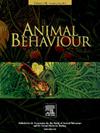社会转换:在自动跟踪的栖息地中,白昼长度驱动草地田鼠群体动态
IF 2.3
2区 生物学
Q2 BEHAVIORAL SCIENCES
引用次数: 0
摘要
在群居物种中,社会性已经在许多场合进化,对个体具有重要的适应性利益和后果。尽管群体生活普遍存在,但研究促进这种行为变化的直接因素仍然具有挑战性。草地田鼠(Microtus pennsylvania)在野外的社会组织中根据季节的变化而变化,这为研究单一物种中支持改变群体行为的机制提供了一个绝佳的机会。雌性草地田鼠在夏季具有很强的领地意识,并保持着自己的领地范围,而在冬季,它们则生活在混合性别群体中。光周期的实验室操作再现了该物种社会行为的季节性变化,在行为测试中通过改变短期二元相互作用证明了这一点。为了评估群体社会动态的变化,我们实施了一个使用射频识别技术的自动跟踪系统,以监测在长日长和短日长的多室栖息地中自由移动的田鼠。我们开发了开源软件来模拟每只动物在栖息地的位置,并描述共同居住的模式。光周期推动了群体社会行为的强劲而显著的变化,再现了野外自然的季节变化。与长时间生活的田鼠相比,白天生活时间短、像冬天一样的田鼠会花更多的时间在一起,形成更大、更均匀的群体,并且更经常地共用一个家室。昼短的田鼠比昼长的田鼠更活跃,但它们是成群休息的,因此同居与活动的超昼夜节律密切相关。这些群体动力学指标将允许对田鼠和其他物种的社会行为的操纵效果进行更细致的评估,因为栖息地和软件都适用于其他啮齿动物。本文章由计算机程序翻译,如有差异,请以英文原文为准。
A social switch: daylength drives meadow vole group dynamics in automatically tracked habitats
Sociality has evolved on numerous occasions, with important fitness benefits and consequences for individuals in group-living species. Despite the prevalence of group living, it remains challenging to study the proximate factors that promote variation in this behaviour. Meadow voles, Microtus pennsylvanicus, vary in social organization in response to seasonal cues in the wild, providing a remarkable opportunity to study mechanisms that support changing grouping behaviour within a single species. In summer, female meadow voles are territorial and maintain exclusive home ranges, while in winter, they live in mixed-sex groups. Laboratory manipulations of photoperiod reproduce seasonal variation in social behaviour in this species, demonstrated by altered short-term dyadic interactions during behavioural tests. To assess changes in group social dynamics, we implemented an automated tracking system using radiofrequency identification technology to monitor free-moving voles housed in long daylengths and short daylengths in multichambered habitats over extended intervals. We developed open-source software to model each animal's position within the habitat and to describe co-occupancy patterns. Photoperiod drove robust and pronounced changes in group social behaviour, recapitulating natural seasonal transitions in the wild. Voles housed in short, winter-like days spent more time in groups, formed larger, more evenly mixed groups and shared a single home-chamber more often than long-day voles. Short-day voles were more active than long-day voles but rested in groups, thus cohabitation was strongly correlated with ultradian rhythms in activity. These metrics of group dynamics will allow more nuanced assessment of the effects of manipulations on social behaviour in voles and other species, as both habitat and software are adaptable for use with other rodents.
求助全文
通过发布文献求助,成功后即可免费获取论文全文。
去求助
来源期刊

Animal Behaviour
生物-动物学
CiteScore
4.60
自引率
8.00%
发文量
236
审稿时长
10.2 weeks
期刊介绍:
Growing interest in behavioural biology and the international reputation of Animal Behaviour prompted an expansion to monthly publication in 1989. Animal Behaviour continues to be the journal of choice for biologists, ethologists, psychologists, physiologists, and veterinarians with an interest in the subject.
 求助内容:
求助内容: 应助结果提醒方式:
应助结果提醒方式:


